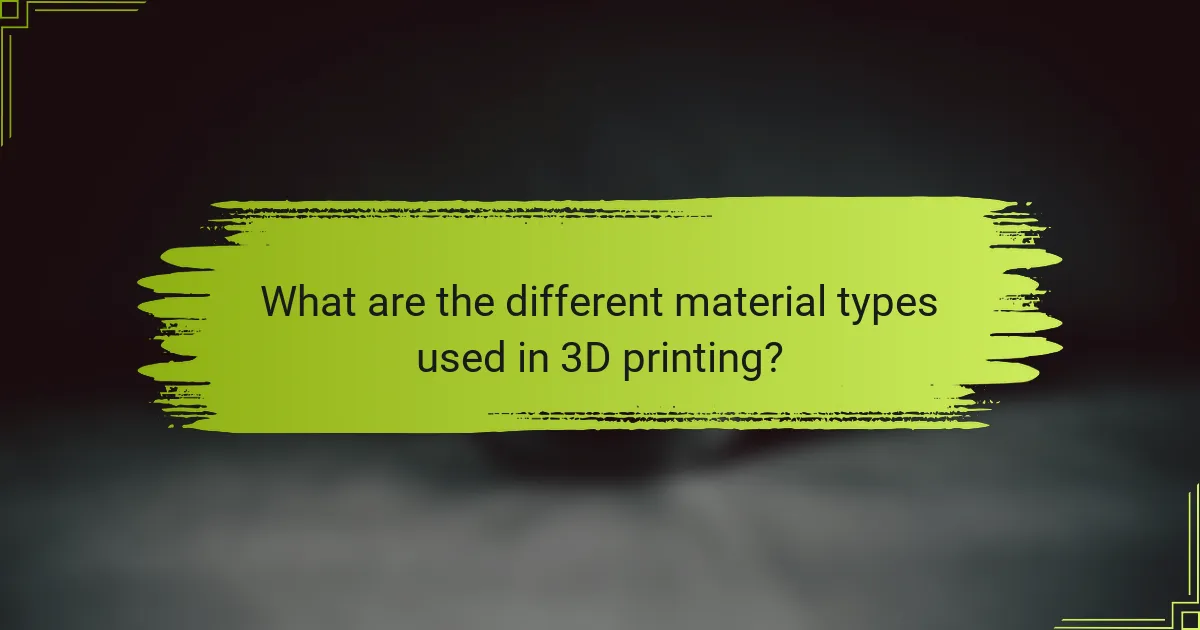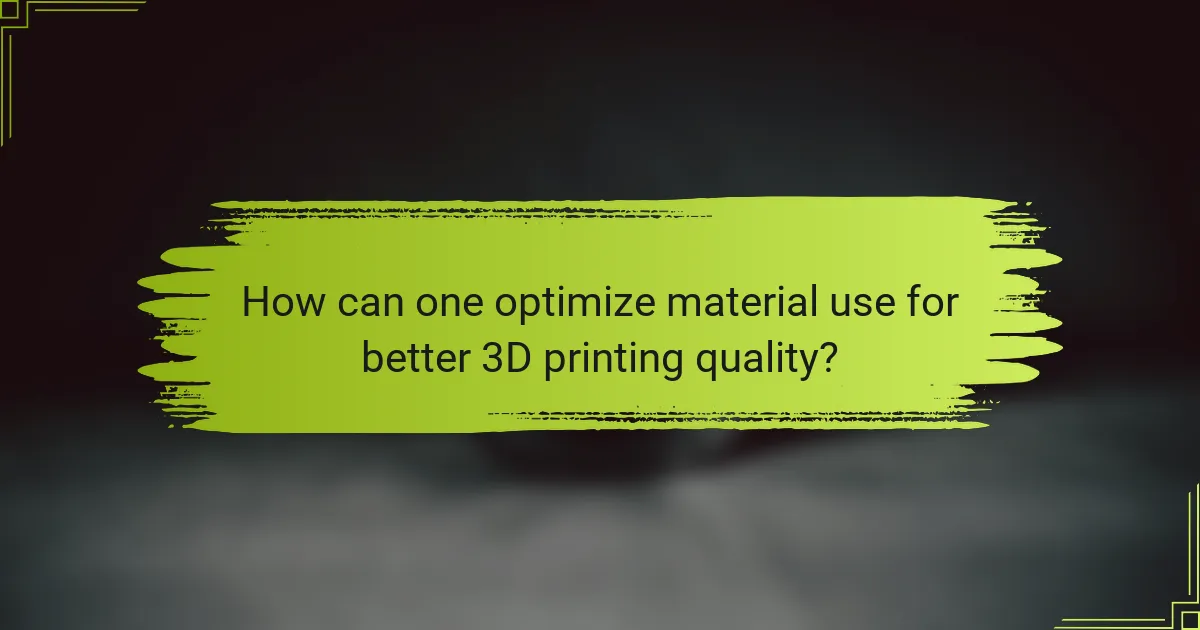
What are the different material types used in 3D printing?
The different material types used in 3D printing include thermoplastics, metals, ceramics, and bio-materials. Thermoplastics, such as PLA and ABS, are the most commonly used materials. They are popular due to their ease of use and availability. Metals, including titanium and aluminum, are utilized for their strength and durability. Ceramics are chosen for their heat resistance and aesthetic qualities. Bio-materials, derived from natural sources, are increasingly used for sustainable applications. Each material type significantly impacts the quality and functionality of 3D printed objects.
How do these material types influence the quality of 3D printed objects?
Different material types significantly influence the quality of 3D printed objects. Each material has distinct properties that affect strength, flexibility, and surface finish. For instance, PLA is known for its ease of printing and good surface quality. ABS offers higher durability and heat resistance but can warp during printing. PETG combines the best of both worlds, providing strength and flexibility without warping.
The layer adhesion varies with material type, impacting the structural integrity of the final print. Materials with better thermal properties tend to have improved layer bonding. Additionally, certain materials can produce smoother finishes, while others may require post-processing for optimal aesthetics.
Research indicates that the choice of material can lead to variations in dimensional accuracy and mechanical performance. For example, a study published in the “Journal of Manufacturing Processes” highlighted that prints made with nylon exhibited superior tensile strength compared to those made with PLA. Thus, selecting the right material is crucial for achieving desired quality outcomes in 3D printing.
What are the key properties of common 3D printing materials?
Common 3D printing materials exhibit key properties such as strength, flexibility, durability, and temperature resistance. PLA, a popular material, is known for its ease of use and biodegradability. It has a tensile strength of around 50 MPa and a glass transition temperature of approximately 60°C. ABS is another common material, recognized for its toughness and impact resistance. It has a tensile strength of about 40 MPa and can withstand temperatures up to 100°C. PETG combines the best of both PLA and ABS, offering strength and flexibility. Its tensile strength is typically around 30 MPa, with a glass transition temperature near 80°C. Nylon is favored for its high durability and flexibility, with a tensile strength of around 50 MPa and excellent wear resistance. Each material’s properties influence the quality and application of 3D printed objects.
How does material choice affect the strength and durability of 3D prints?
Material choice significantly affects the strength and durability of 3D prints. Different materials exhibit varying mechanical properties. For instance, PLA is easy to print but has lower tensile strength compared to ABS. ABS offers better impact resistance and heat tolerance. Nylon is known for its flexibility and durability, making it suitable for functional parts. The layer adhesion also varies by material; stronger adhesion leads to better overall strength. Research indicates that materials like PETG combine strength with flexibility, making them ideal for resilient prints. The choice of material directly influences the performance and longevity of the final product.
Why is material selection critical in 3D printing?
Material selection is critical in 3D printing because it directly influences the final product’s quality and performance. Different materials have unique properties that affect strength, flexibility, and durability. For instance, thermoplastics like ABS are known for their toughness, while PLA is more environmentally friendly but less durable. The choice of material also impacts the printing process itself, including temperature settings and layer adhesion. According to a study published in the Journal of Manufacturing Processes, material selection can improve the mechanical properties of 3D printed parts by up to 30%. Therefore, selecting the appropriate material is essential for achieving desired outcomes in 3D printing.
What impact does material type have on print resolution and detail?
Material type significantly affects print resolution and detail in 3D printing. Different materials have varying physical properties, such as viscosity and layer adhesion. For instance, PLA typically allows for finer details due to its lower viscosity compared to ABS. This results in sharper edges and smoother surfaces. Additionally, flexible materials may struggle with precision, leading to less defined features. The thermal properties of materials also influence resolution; some materials warp or shrink during cooling, affecting dimensional accuracy. Studies indicate that higher-quality filaments yield better resolution, as seen in research published by the Journal of Materials Processing Technology. This research highlights that material selection directly correlates with print quality outcomes.
How does the material affect the post-processing of 3D prints?
The material used in 3D printing significantly influences the post-processing methods required. Different materials have unique properties that dictate how they can be treated after printing. For example, thermoplastics like PLA are easier to sand and paint compared to more rigid materials like ABS.
Materials like nylon may require specialized solvents for smoothing, while others like resin demand careful handling due to their sensitivity to UV light. The thermal properties of a material also affect post-processing; materials with high melting points may need more advanced techniques like vapor smoothing.
Additionally, the surface finish of the material impacts the effectiveness of post-processing techniques. A rougher surface may require more extensive sanding or finishing to achieve a desired aesthetic. Thus, the choice of material directly determines the complexity and type of post-processing needed to enhance the final print quality.

What factors should be considered when choosing materials for 3D printing?
When choosing materials for 3D printing, several factors must be considered. First, the intended application of the printed object is crucial. Different applications may require varying strength, flexibility, or heat resistance. Second, the material’s compatibility with the 3D printer is essential. Each printer has specific material requirements, including filament diameter and melting temperature. Third, the mechanical properties of the material should be evaluated. This includes tensile strength, impact resistance, and durability. Fourth, the ease of use of the material is important. Some materials are easier to print and require less post-processing. Fifth, cost considerations play a role. The price of materials can vary significantly, impacting project budgets. Lastly, environmental factors should also be taken into account. Some materials are biodegradable, while others are not, affecting sustainability.
How do environmental conditions affect material performance in 3D printing?
Environmental conditions significantly impact material performance in 3D printing. Factors such as temperature, humidity, and airflow can alter the properties of printing materials. High temperatures may lead to warping or deformation of certain plastics. Low humidity can cause materials to become brittle or less adhesive. Airflow can affect the cooling rate, influencing layer adhesion and surface finish. For instance, ABS is prone to warping in cooler environments, while PLA performs better in stable conditions. Studies show that maintaining optimal environmental conditions enhances print quality and reduces failures.
What role does temperature play in the behavior of different materials?
Temperature significantly influences the behavior of different materials. It affects properties such as strength, flexibility, and thermal expansion. For metals, higher temperatures can reduce hardness and increase ductility. In polymers, temperature changes can lead to variations in viscosity, impacting flow during processes like 3D printing. Glass transition temperatures are critical for thermoplastics, determining their usability in various applications. Additionally, temperature can induce phase changes in materials, such as the transition from solid to liquid. This is essential for processes like melting and solidification in manufacturing. Overall, understanding temperature’s role is vital for optimizing material performance in 3D printing.
How does humidity influence the quality of 3D printed items?
Humidity negatively influences the quality of 3D printed items. High humidity can cause materials like PLA and ABS to absorb moisture. This moisture leads to issues such as bubbling and poor layer adhesion during printing. Additionally, excessive humidity can result in filament degradation, affecting the overall print strength. Studies show that optimal humidity levels for 3D printing are typically between 30% and 50%. Above this range, the risk of print defects increases significantly. Maintaining controlled humidity is crucial for achieving high-quality prints.
What are the economic implications of different material choices?
Different material choices in 3D printing significantly impact economic factors such as cost, waste, and production efficiency. The selection of materials affects the overall manufacturing costs. For instance, high-quality polymers may have higher upfront costs but can reduce waste and improve durability. Materials like PLA are often cheaper but may not provide the same performance benefits.
Production efficiency is also influenced by material choices. Certain materials allow for faster print speeds and less post-processing, which can lower labor costs. For example, using nylon can lead to stronger parts that require less reinforcement, saving time and resources.
Additionally, the market demand for specific materials can fluctuate, impacting pricing. According to a report by SmarTech Analysis, the demand for advanced materials in 3D printing is expected to grow, influencing their economic viability.
Ultimately, the economic implications of material choices encompass initial costs, production efficiency, and long-term value, all of which are crucial for businesses to consider when selecting materials for 3D printing.
How do material costs vary across different types of 3D printing materials?
Material costs for 3D printing vary significantly based on the type of material used. For example, thermoplastics like PLA and ABS typically cost between $20 to $50 per kilogram. In contrast, specialty materials such as nylon or PETG may range from $30 to $70 per kilogram. Metal powders used in metal 3D printing can be much more expensive, often exceeding $100 per kilogram. Additionally, resins for SLA printing can range from $50 to $150 per liter, depending on their properties. The cost differences arise from factors such as material composition, manufacturing processes, and intended applications. Consequently, choosing the right material can have a substantial impact on overall production costs and project feasibility.
What are the long-term cost considerations associated with material selection?
Long-term cost considerations associated with material selection include durability, maintenance, and lifecycle costs. Durable materials reduce the frequency of replacements, leading to lower long-term expenses. Maintenance costs vary by material type; some materials require more upkeep, impacting overall costs. Lifecycle costs encompass not just the initial purchase price but also energy consumption and disposal costs. For instance, materials that are energy-intensive during production may result in higher operational expenses over time. Additionally, the environmental impact of disposal can influence costs, particularly with regulations on waste management. Therefore, choosing materials with a longer lifespan and lower maintenance requirements can significantly reduce total costs in the long run.

How can one optimize material use for better 3D printing quality?
To optimize material use for better 3D printing quality, select the appropriate filament type. Different filaments have unique properties that affect print quality. For example, PLA offers ease of use and good surface finish. ABS is stronger but requires higher temperatures. Adjust print settings to match the chosen material. Layer height, print speed, and temperature should be tailored accordingly. Use infill settings wisely to balance strength and material use. A lower infill percentage can reduce material consumption without sacrificing quality. Regularly calibrate the printer to ensure precise material flow. Consistent flow leads to better adhesion and fewer defects. Proper storage of materials prevents moisture absorption, which can degrade print quality.
What best practices should be followed for material preparation?
Best practices for material preparation in 3D printing include proper storage, accurate measurement, and thorough drying of materials. Proper storage prevents moisture absorption, which can degrade material quality. Accurate measurement ensures the correct material-to-solvent ratio, impacting print integrity. Thorough drying removes any residual moisture, which can cause defects during printing. These practices lead to improved print quality and consistency. Studies show that materials with optimal moisture content yield higher mechanical properties and better surface finish.
How does proper storage of materials impact their performance?
Proper storage of materials significantly enhances their performance in 3D printing. Materials such as filaments are sensitive to environmental conditions. Exposure to moisture can lead to degradation, affecting print quality. For instance, PLA filament can absorb water, resulting in weak prints and bubbling during extrusion. Storing materials in airtight containers can mitigate this issue. Temperature control also plays a crucial role. High temperatures can cause materials to soften prematurely, leading to warping. Additionally, UV exposure can degrade certain materials, reducing their strength. Therefore, proper storage directly influences the integrity and reliability of 3D printed objects.
What techniques can enhance the adherence of materials during printing?
Techniques that can enhance the adherence of materials during printing include optimizing bed temperature, using adhesion aids, and adjusting print speed. A heated print bed can improve material adhesion by reducing warping and promoting better layer bonding. Adhesion aids, such as glue sticks or specialized sprays, create a surface that enhances grip between the material and the print bed. Adjusting print speed can also influence adhesion; slower speeds allow for better material flow and layer bonding. Proper calibration of the nozzle height ensures the material is deposited correctly, further improving adherence. Each of these techniques has been validated through practical applications in various 3D printing scenarios, demonstrating their effectiveness in enhancing print quality.
What troubleshooting tips exist for common material-related issues in 3D printing?
Ensure proper bed adhesion by leveling the print bed and using adhesives if necessary. Check the filament diameter to confirm it matches the printer specifications. Adjust the nozzle temperature according to the material type to prevent clogging. Monitor the print speed; slower speeds can improve print quality with certain materials. Inspect for moisture in the filament, as wet filament can lead to bubbling and poor prints. Clean the nozzle regularly to avoid blockages that affect material flow. Verify the compatibility of the material with the printer’s settings to ensure optimal performance.
How can one identify and resolve material-related print failures?
To identify and resolve material-related print failures, one should first examine the print settings and material compatibility. Incorrect temperature settings can lead to poor adhesion or warping. Checking the material’s recommended temperature range is essential for optimal results.
Next, inspect the filament for moisture absorption. Moisture can cause bubbles and weak spots in the print. Storing filament in a dry environment helps maintain its quality.
Evaluate the extrusion process for clogs or inconsistent flow. A clogged nozzle can disrupt material delivery, leading to incomplete layers. Regularly cleaning the nozzle can prevent this issue.
Monitor the print bed adhesion. If the material does not stick properly, it can lead to failed prints. Using adhesives or adjusting the bed surface can enhance adhesion.
Lastly, perform a test print with a small model to assess material behavior before larger projects. This approach helps identify potential issues early.
What adjustments can be made to printing settings to improve material performance?
Adjustments to printing settings can significantly enhance material performance. Increasing the print temperature can improve layer adhesion. This leads to stronger and more durable prints. Adjusting the print speed can also optimize material flow. Slower speeds often result in better detail and reduced warping. Modifying the layer height can affect the overall strength. Thicker layers can enhance speed but may reduce detail. Conversely, thinner layers improve detail but increase print time. Tweaking infill density can provide balance between strength and material usage. Higher infill percentages yield stronger parts, while lower percentages save material. Finally, calibrating the nozzle size can affect extrusion consistency. A properly calibrated nozzle ensures optimal material flow and reduces clogs.
The main entity of this article is the various material types used in 3D printing and their influence on print quality. The article provides a comprehensive overview of material categories, including thermoplastics, metals, ceramics, and bio-materials, and discusses how each material’s unique properties affect strength, durability, and surface finish of 3D printed objects. Key factors such as print resolution, post-processing requirements, and environmental considerations are examined, along with practical advice for material selection and optimization techniques to enhance 3D printing outcomes. Additionally, the economic implications of different materials are explored, highlighting cost variations and long-term considerations associated with material choices.